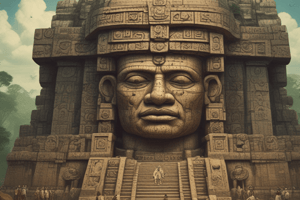Podcast
Questions and Answers
What does the name Olmec mean?
What does the name Olmec mean?
the rubber people
In which present-day Mexican states did the Olmec civilization primarily live?
In which present-day Mexican states did the Olmec civilization primarily live?
Veracruz and Tabasco
What significant invention is attributed to the Olmec?
What significant invention is attributed to the Olmec?
- Ceremonial centers
- Colossal heads
- Writing systems
- All of the above (correct)
The Olmec civilization had a highly developed writing system.
The Olmec civilization had a highly developed writing system.
Which of the following deities was significant in Olmec religion?
Which of the following deities was significant in Olmec religion?
What material is primarily used in the construction of Olmec colossal heads?
What material is primarily used in the construction of Olmec colossal heads?
The Olmec civilization is believed to be the originators of the Mesoamerican ball game, known as _____ .
The Olmec civilization is believed to be the originators of the Mesoamerican ball game, known as _____ .
Which cultural practice among the Maya was strongly influenced by the Olmec?
Which cultural practice among the Maya was strongly influenced by the Olmec?
What is the significance of the Cascajal Block?
What is the significance of the Cascajal Block?
During which period did the Maya civilization experience significant city founding and population growth?
During which period did the Maya civilization experience significant city founding and population growth?
The ancient Maya were known for their poor understanding of time and astronomy.
The ancient Maya were known for their poor understanding of time and astronomy.
Flashcards are hidden until you start studying
Study Notes
Olmec Civilization
- First major civilization in Mexico
- Lived in tropical lowlands on the Gulf of Mexico
- Named after Nahuatl word for "rubber people"
- May have been the first to convert rubber tree latex into usable material
- Known for colossal stone heads carved from basalt
- Influenced many later civilizations, including the Maya
- Originated the Mesoamerican Ballgame
- Practiced ritual bloodletting
- Earliest evidence of their civilization dates back to around 1600 BCE
Olmec Inventions & Contributions
- Colossal Heads: Carved stone heads believed to represent rulers or elite figures. Discovered mainly at San Lorenzo and La Venta.
- La Venta and San Lorenzo Ceremonial Centers: Among the earliest planned ceremonial centers in Mesoamerica. Featured platforms, pyramids, and courtyards for religious and political ceremonies. The Great Pyramid of La Venta is an early pyramidal structure.
- Olmec Dragon and Other Deities: Developed a pantheon of gods that influenced Mesoamerican religious practices. The Olmec Dragon, a sky god associated with rulers and power, is one example. The Were-Jaguar, a hybrid figure, is linked to shamanism and fertility.
- The Cascajal Block and Early Writing: Stone tablet suggests the Olmecs may have developed an early writing system. Contains 62 symbols resembling hieroglyphic writing.
- The Mesoamerican Ball Game: Believed to be the creators of the Mesoamerican ball game, pok-ta-pok (or pok-a-tok). Evidence of ball courts and rubber balls found at Olmec sites, like San Lorenzo. The game had religious and political significance.
Mayan Civilization
- Culturally affiliated people who continue speaking their native languages
- Still often use the ancient 260-day ritual calendar for religious practices
- United by belief systems, cultural practices (architectural style), and a writing system
- Left an artistic legacy ranging from sculptures to murals
- Created the most advanced Mesoamerican writing system, which is logo-syllabic
- Advanced understanding of time, astronomy, and a complex calendrical system
- History divided into three periods:
- Pre-Classic (1000 BCE - 250 CE)
- Classic (250 - 900 CE)
- Divided into Early Classic (250 - 550 CE) and Late Classic (600 - 900 CE)
- Post-Classic (900 - 1521 CE)
- Important Maya cities include Tikal, Palenque, and Copán
Mayan Inventions & Contributions
- Maya Calendar Systems (Tzolk'in and Haab'): Developed two calendar systems used for religious practices and tracking time. The Tzolk'in is a 260-day ritual calendar, while the Haab' is a 365-day solar calendar.
- Maya Writing System: Used glyphs representing words or syllables. One of the few pre-Hispanic writing systems in Mesoamerica that has been deciphered.
- Maya Architectural Style: Known for their ornate and monumental architecture. Built pyramids, temples, palaces, and observatories. Examples include the Great Plaza at Tikal and the Palace at Palenque.
- Maya Mathematics: Developed a sophisticated number system based on a vigesimal (base 20) system. Employed a dot to represent one and a bar to represent five. Mayan mathematicians independently developed a concept of zero.
- Maya Astronomy: Made significant observations of celestial bodies, including Venus and the Moon. Built observatories to study the stars and planets.
- Maya Art: Famous for diverse art forms, encompassing sculptures, murals, pottery, and jade carvings. Examples include the Temple of Inscriptions at Palenque and the murals at Bonampak.
Studying That Suits You
Use AI to generate personalized quizzes and flashcards to suit your learning preferences.




